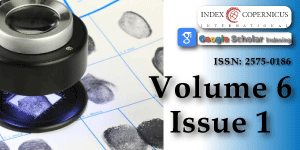Forensic science deals with safety armour during warfare explosives
Main Article Content
Abstract
Forensic analysis of explosives includes analysis of post-explosion residues, and detection and identification of traces of explosives on suspects’ hands, on clothing, and on other related items. Preliminary field tests may be used for screening the debris on the explosion site. They include commercially available explosive vapor detectors and chemical color tests. Like post-explosion residues, personal items suspected to contain traces of explosives and hand-swabs, are often heavily contaminated. It is therefore of major importance that the analytical procedures have to include good screening, clean-up, and extraction methods. The main explosives dealt with in this chapter include nitroaromatic explosives, such as 2,4,6-trinitrotoluene (TNT) and 2,4,6, N-tetranitro-N-methyl aniline (tetryl), nitrate esters, such as ethylene glycol dinitrate (EGDN), glycerol trinitrate (nitroglycerin, NG), and pentaerythritol tetranitrate (PETN), and nitramine explosives, such as 1,3,5- trinitro-1,3,5-triazacyclohexane, (RDX) and 1,3,5,7-tetranitro-1,3,5,7-tetrazacyclooctane (HMX), as well as mixtures containing one or more of these explosives. Additional explosives include triacetone triperoxide (TATP) and ammonium nitrate (AN), NH4NO3
Article Details
Copyright (c) 2022 2022 Saha D, et al.

This work is licensed under a Creative Commons Attribution 4.0 International License.
Patel VR, Parmar JN, Aal LB, Sen DJ. Poison gas: as a lethal weapon in chemical warfare. Int J Pharmaceut Res Bio-Sci. 2014; 3: 332-357.
Krehl POK. History of Shock Waves, Explosions and Impact: A Chronological and Biographical Reference. Springer Science & Business Media. 1970; 2008.
Borak J, Sidell FR. Agents of chemical warfare: Sulfur mustard. Ann Emerg Med. 1992; 21: 303–308. PubMed: https://pubmed.ncbi.nlm.nih.gov/1536492/
Cooper, Paul W. Chapter 4: Use forms of explosives. Explosives Engineering. Wiley-VCH. 1996; 51–66.
Assovskiy IG. Direct laser initiation of open secondary explosives. J Phys. 2015; 653: 012-014.
Ellison DH. Handbook of Chemical and Biological Warfare Agents, Second Edition. CRC Press. 2007; 456.
Gao Y, Olomon PM. HCN Survey of Normal Spiral, Infrared‐luminous, and Ultraluminous Galaxies. Astrophysical J Suppl Series. 2004; 152: 63–80.
Borowitz JL, Gunasekar PG, Isom GE. Hydrogen cyanide generation by mu-opiate receptor activation: possible neuromodulatory role of endogenous cyanide. Brain Res. 1997; 768: 294–300. PubMed: https://pubmed.ncbi.nlm.nih.gov/9369328/
Hu H, Fine J, Epstein P, Kelsey K, Reynolds P, et al. Tear gas--harassing agent or toxic chemical weapon? JAMA. 1989; 262: 660–663. PubMed: https://pubmed.ncbi.nlm.nih.gov/2501523/
Levin BC, Paabo M, Gurman JL, Harris SE, Braun E. Toxicological interactions between carbon monoxide and carbon dioxide. Toxicology. 1987; 47: 135–164. PubMed: https://pubmed.ncbi.nlm.nih.gov/3120355/
Dabrowska MI, Becks LL, Lelli JL, Jr, Levee MG, Hinshaw DB. Sulfur Mustard Induces Apoptosis and Necrosis in Endothelial Cells. Toxicol Appl Pharmacol. 1996; 141: 568–583. PubMed: https://pubmed.ncbi.nlm.nih.gov/8975783/
Abu-Qare AW, Abou-Donia MB. Sarin: health effects, metabolism, and methods of analysis. Food Chem Toxicol. 2002; 40: 1327–1333. PubMed: https://pubmed.ncbi.nlm.nih.gov/12387297/
Kovarik Z, Radić Z, Berman HA, Simeon-Rudolf V, Reiner E, et al. Acetylcholinesterase active centre and gorge conformations analysed by combinatorial mutations and enantiomeric phosphonates. Biochem J. 2003; 373: 33–40. https://pubmed.ncbi.nlm.nih.gov/12665427/
Millard CB, Kryger G, Ordentlich A, Greenblatt HM, Harel M, et al. Crystal Structures of Aged Phosphonylated Acetylcholinesterase: Nerve Agent Reaction Products at the Atomic Level. Biochemistry. 1999; 38: 7032–7039. https://pubmed.ncbi.nlm.nih.gov/10353814/
Petroianu G. Pharmacists Adolf Schall and Ernst Ratzlaff and the synthesis of tabun-like compounds: a brief history. Die Pharmazie. 2014; 69: 780–784. PubMed: https://pubmed.ncbi.nlm.nih.gov/25985570/
Jokanović M. Biotransformation of organophosphorus compounds. Toxicology. 2001; 166: 139–160. PubMed: https://pubmed.ncbi.nlm.nih.gov/11543910/
Cowell EM. Chemical Warfare and the Doctor. Bri Med J. 1939; 2: 736-738. PubMed: https://pubmed.ncbi.nlm.nih.gov/20782694/
Fieldner AC, Katz SH, Kinney SP, Longfellow ES. Poisonous gases from carbon tetrachloride fire extinguishers. J Franklin Institute. 1920; 543–565.
Wagner G. Sitzung der russischen chemischen Gesellschaft am 7/19. Berichte de Deutschen Chemischen Gesellschaft. 1876; 9: 1687–1688.
Snyder LE, Buhl D. Observations of Radio Emission from Interstellar Hydrogen Cyanide. Astrophysical J. 1971; 163: L47–L52.
Ramasamy S, Singh S, Taniere P, Langman MJS, Eggo MC. Sulfide-detoxifying enzymes in the human colon are decreased in cancer and upregulated in differentiation. Am J Physiol. 2006; 291: G288–G296. PubMed: https://pubmed.ncbi.nlm.nih.gov/16500920/
Piantadosi CA. Carbon monoxide poisoning. Undersea Hyperb Med. 2004; 31: 167–177. PubMed: https://pubmed.ncbi.nlm.nih.gov/15233173/
Bunn G. Banning Poison Gas and Germ Warfare: Should the United States Agree. Wisconsin Law Rev. 1969; 2: 405.
Duchovic RJ, Vilensky JA. Mustard Gas: Its Pre-World War I History. J Chem Educ. 2007; 84: 944.
Heitmann W, Strehlke G, Ethers DM, Aliphatic Ullmann's Encyclopedia of Industrial Chemistry, Wiley-VCH, Weinheim, 2002

